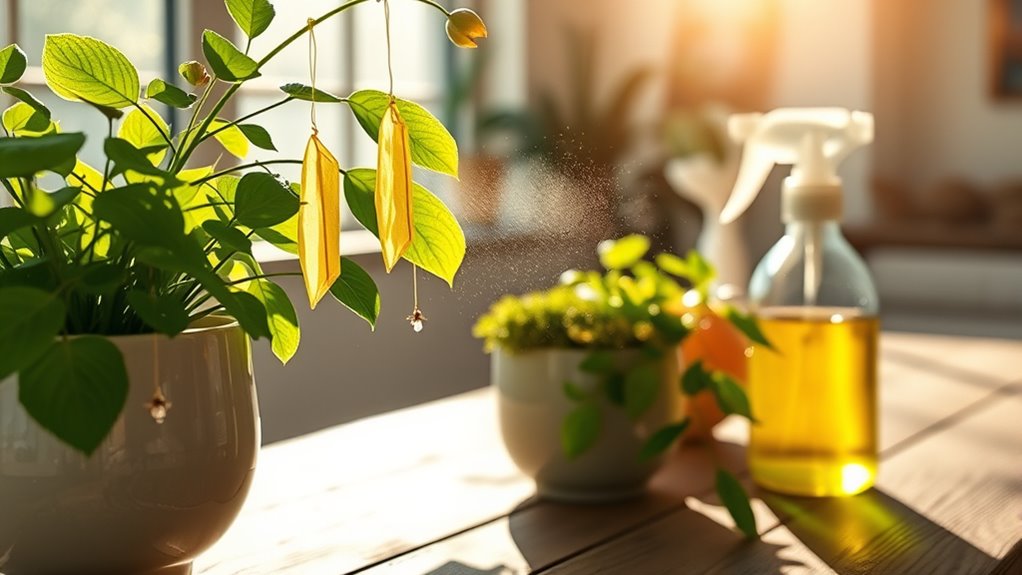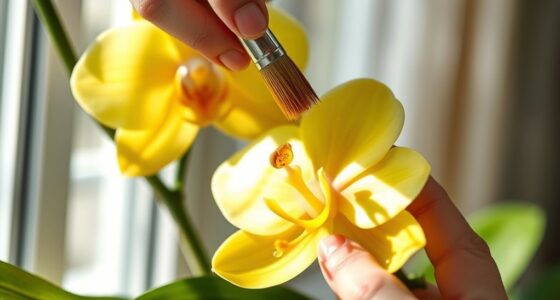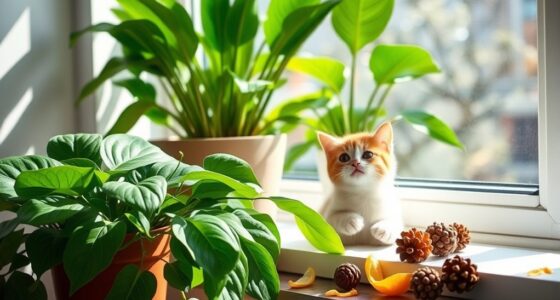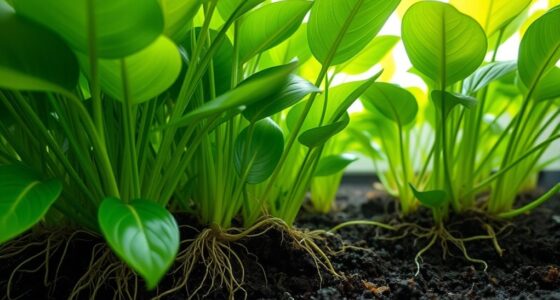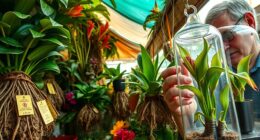To keep gnats away from your indoor plants, start by monitoring for signs of infestations with yellow sticky traps. Let your soil dry out between waterings and improve drainage by mixing in perlite. Use homemade vinegar traps and consider natural remedies like neem oil or diatomaceous earth. Keep your environment tidy and ensure good air circulation. Regular checks on plant health can also help. There’s a lot more you can do to protect your plants!
Key Takeaways
- Allow soil to dry between waterings and monitor moisture levels to prevent overwatering, a primary breeding ground for gnats.
- Use yellow sticky traps placed near plants to monitor and capture adult gnats effectively.
- Improve soil drainage by mixing in perlite or coarse sand to reduce moisture retention.
- Regularly clean up decomposing plant material and replace the top inch of soil to eliminate potential larvae.
- Employ natural remedies like neem oil or hydrogen peroxide solutions to target gnat larvae and deter adult gnats.
Understanding the Gnat Life Cycle
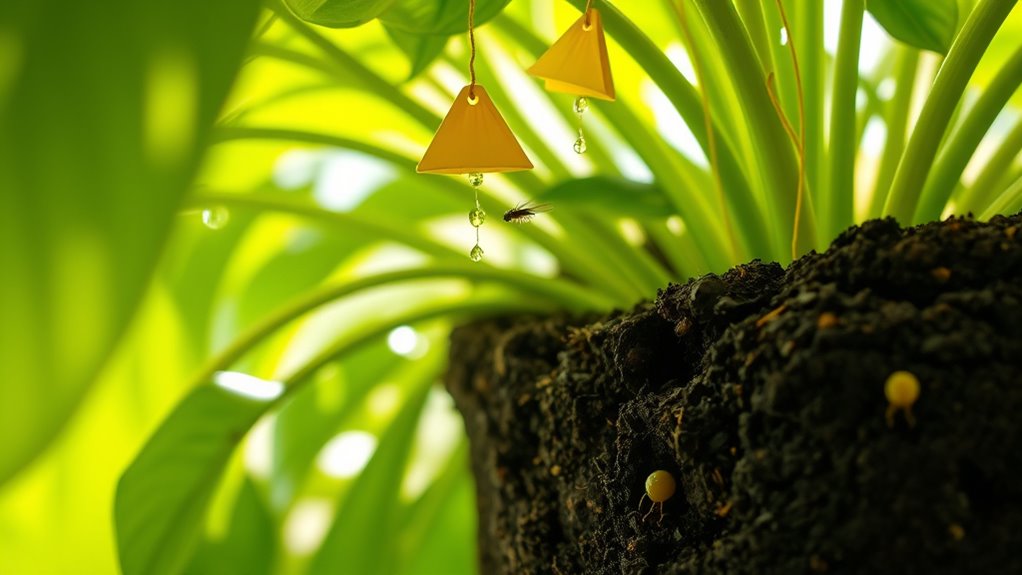
Understanding the gnat life cycle is crucial if you want to keep these pesky pests away from your indoor plants.
Gnats begin their life as eggs, usually laid in moist soil or organic debris. A female can lay hundreds of eggs, which hatch within 3 to 6 days. Eggs hatch within six days after being laid, leading to a rapid increase in their population. Additionally, regularly updating plans for plant care can help prevent infestations. Educational toys can provide significant developmental benefits and are essential for fostering a healthy environment, just like maintaining your plants is key to preventing gnats. Keeping your indoor environment clean and tidy is also important for avoiding unwanted pests, as proper airflow can deter gnat breeding grounds.
Once hatched, the larvae emerge, legless with shiny black heads, and feast on plant roots and organic matter. This larval stage lasts about 12-14 days and can cause significant damage to your plants.
Adult gnats, which live for about 7-10 days, can reproduce quickly, laying up to 200 eggs during their short lifespan.
Soil Drying Techniques
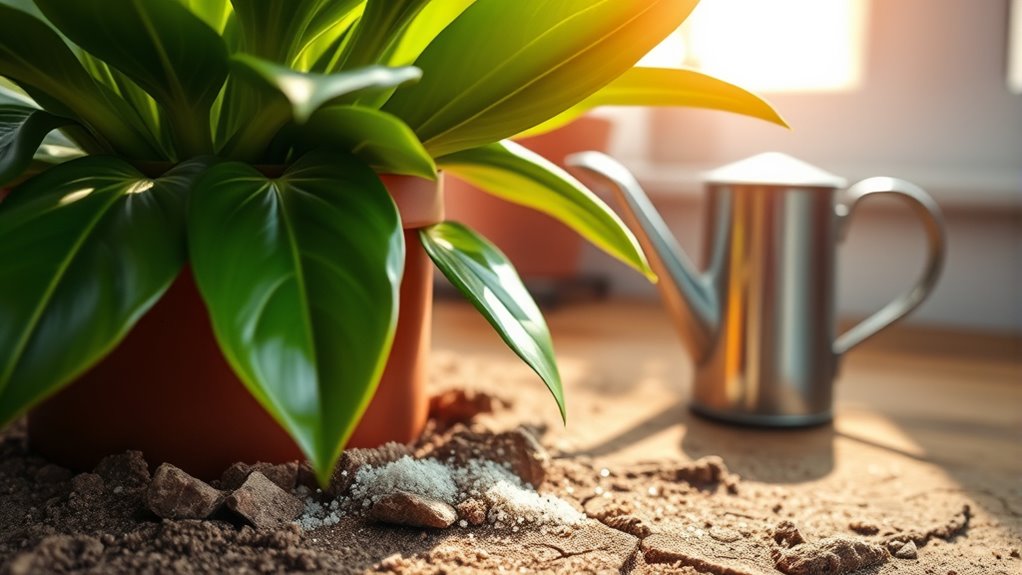
To keep gnats at bay, it’s essential to dry out the soil of your indoor plants effectively.
Start by boosting airflow; place fans around your plants to speed up evaporation. Positioning your plants in direct sunlight will also enhance drying. Additionally, improving soil structure by mixing in perlite or coarse sand can create spaces for better drainage and air penetration. Implementing these techniques can lead to increased energy efficiency in your home, as drying soil reduces the need for excess watering. Using a portable dehumidifier can also help manage humidity levels indoors, further assisting in pest control. Furthermore, keeping the soil dry can help prevent digestive issues that may arise from overwatering.
Boost airflow and place your plants in direct sunlight to accelerate soil drying and keep gnats away.
Loosen compacted soil for better air circulation and moisture escape. Don’t forget to remove any standing water—scoop out puddles or use towels to absorb excess moisture.
If the humidity is high, consider using a dehumidifier to help lower moisture levels in the air.
Regularly monitor soil moisture to avoid overwatering.
Effective Traps and Devices
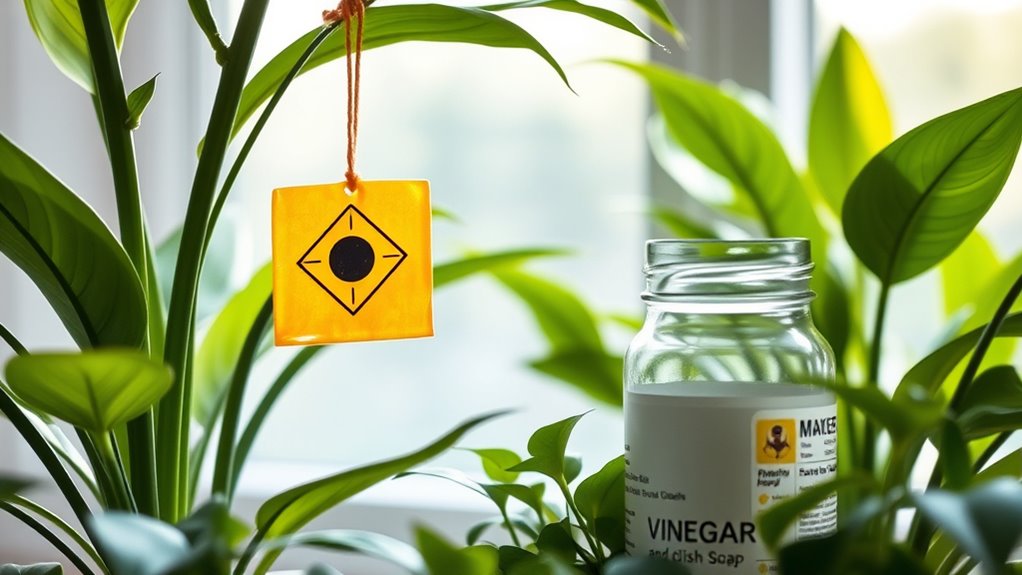
While managing gnats can be a challenge, employing effective traps and devices can significantly reduce their numbers around your indoor plants.
Start with yellow sticky traps, placing them flat on the soil or hanging near plants. Plug-in gnat traps using LED lights and fans offer a quick solution, while fruit fly traps can also catch gnats. Additionally, using sticky traps helps capture adult gnats, which is essential for reducing their population.
For a homemade option, create vinegar and soap traps to lure and trap them. Don’t forget candle and water setups, as gnats are attracted to light.
Regularly check and replace traps to maintain their effectiveness. Combining traps with other methods enhances your control strategy, ensuring your indoor plants remain gnat-free.
Natural Remedies for Gnat Control

Effective traps can help manage gnats, but natural remedies offer an alternative approach to control these pests around your indoor plants. Try using chamomile and cinnamon, which are natural fungicides that eliminate gnats’ food sources in the soil. You can also apply a hydrogen peroxide solution—mix one part hydrogen peroxide with four parts water—to kill larvae without harming your plants. Using quick fixes like these can effectively reduce gnat populations in your indoor garden. Additionally, maintaining a regular cleaning schedule for your plants and their surroundings can help prevent gnat infestations. Bacillus thuringiensis (Bt) is another option; it effectively targets gnat larvae and is available in mosquito bits. Furthermore, incorporating soluble fiber from chia seeds into your diet can support gut health, which may enhance your overall gardening experience. For added protection, sprinkle diatomaceous earth on the soil to dehydrate gnats. Lastly, consider using potato slices to monitor infestations and remove larvae, keeping your indoor garden healthy and gnat-free. Remember that increasing digital literacy among seniors can empower them to explore gardening and pest control techniques effectively.
Environmental Adjustments for Indoor Plants
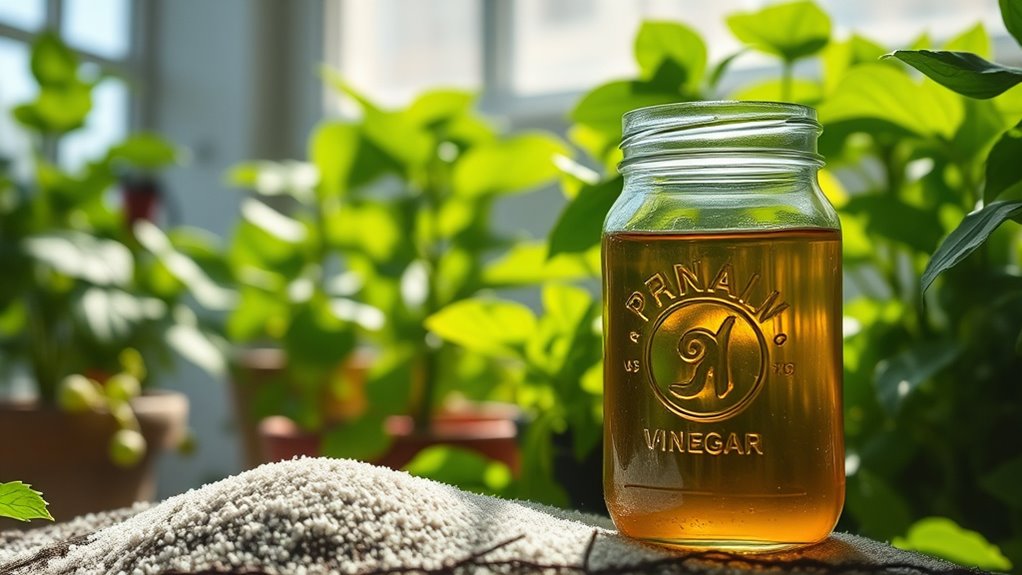
Creating the right environment for your indoor plants is essential for their health and vitality.
Ensure that you choose plants suited to indoor conditions, like tropical species, and place them near windows for optimal light. Remember that delicate plants thrive in bright, indirect sunlight, while tougher ones can handle intense light. Light meters can be used to measure the intensity of sunlight in your home, helping you find the best spots for your plants. Additionally, understanding astrological signs may provide insights into which plants resonate best with your personal energy and preferences. Incorporating lighting design principles can further enhance the ambiance for your plants. A well-designed space with natural materials can also contribute to a more inviting atmosphere for your indoor garden.
Maintain temperatures similar to tropical climates and keep humidity levels high using humidifiers or pebble trays. Good air circulation is crucial, so avoid overcrowding and ensure enough space between plants.
Finally, be mindful of drafts; placing your plants away from vents and drafty areas will help prevent stress and damage, promoting a healthier environment free from pests like gnats.
Soil Management Techniques
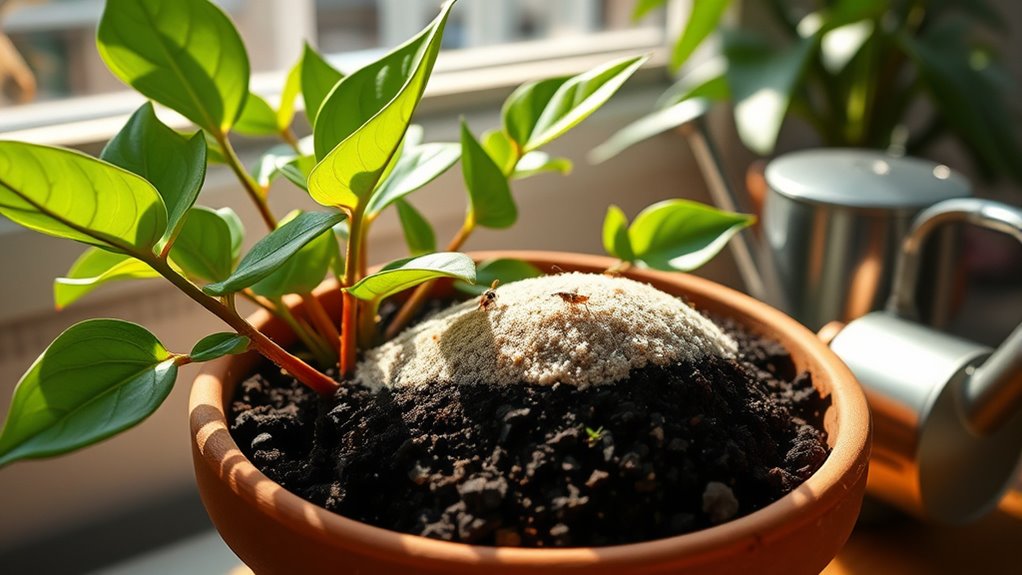
Maintaining a healthy environment for your indoor plants goes beyond just adjusting their surroundings; soil management techniques play a significant role in keeping gnats at bay.
Start by controlling soil moisture—wait until the top 50-60% of the soil is dry before watering. Using moisture meters can help you prevent overwatering. Keeping a dry environment is essential to discourage gnat egg-laying and drainage importance cannot be overlooked as it prevents waterlogging that attracts pests. A clean environment also reduces allergens and pollutants, which helps support the overall health of your plants. Regularly checking for caffeine content in coffee grounds can also be beneficial as it may act as a natural pest deterrent.
Aerate your soil with chopsticks to improve air circulation, and consider bottom watering to keep the surface dry.
Regularly clean decomposing plant material and ensure you use high-quality, pasteurized compost. Incorporate inorganic materials like perlite to enhance drainage.
If needed, replace the top inch of soil to eliminate larvae. These practices will help create an environment less inviting to gnats and support your plants’ overall health.
Preventive Measures to Avoid Infestations
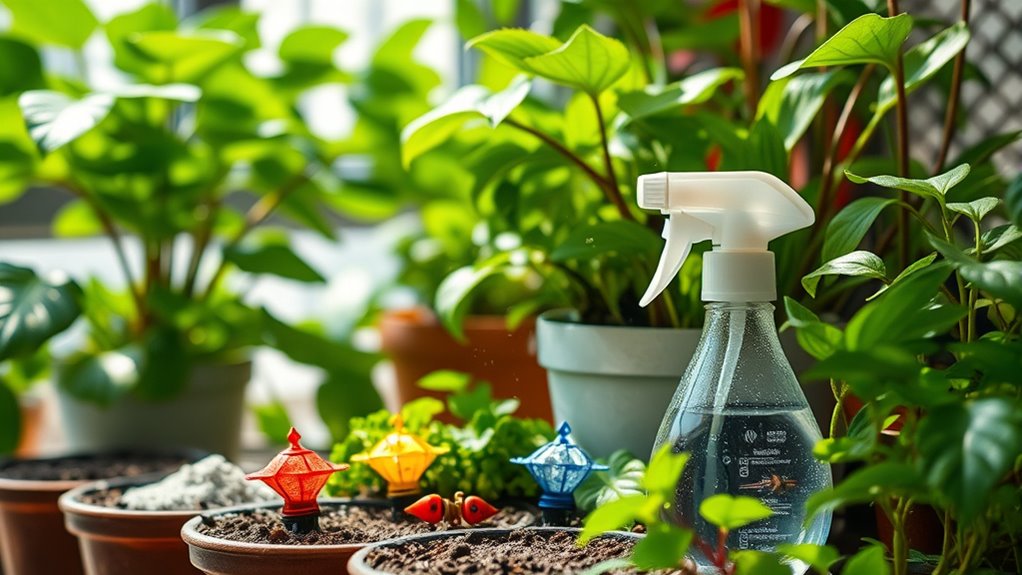
To keep gnats from becoming a nuisance in your indoor garden, it’s essential to implement preventive measures that target their breeding conditions.
Start by avoiding overwatering; let the soil dry between waterings and regularly check soil moisture. Remember to empty any standing water from plant saucers. Fungus gnats primarily lay their eggs in damp soil, so maintaining appropriate moisture levels is crucial. Providing proper diet for your plants can also improve their resilience against pests. Additionally, understanding emergency preparedness essentials can help you create a more stable and resilient indoor environment for your plants. Using herbal infusion machines to create nutrient-rich solutions may also boost plant health and deter pests.
Avoid overwatering your plants; allow the soil to dry between waterings and check moisture levels regularly.
When introducing new plants, inspect them for signs of gnats and quarantine them for at least 17 days to monitor for activity.
Adjust your environment by reducing humidity, ensuring good air circulation, and fixing any leaks.
Maintain cleanliness around your plants by removing dead material and keeping the area free from debris.
Using yellow sticky traps near infested plants can help monitor gnat populations, but combine this with other prevention methods for the best results.
Utilizing Neem Oil and Other Natural Pesticides
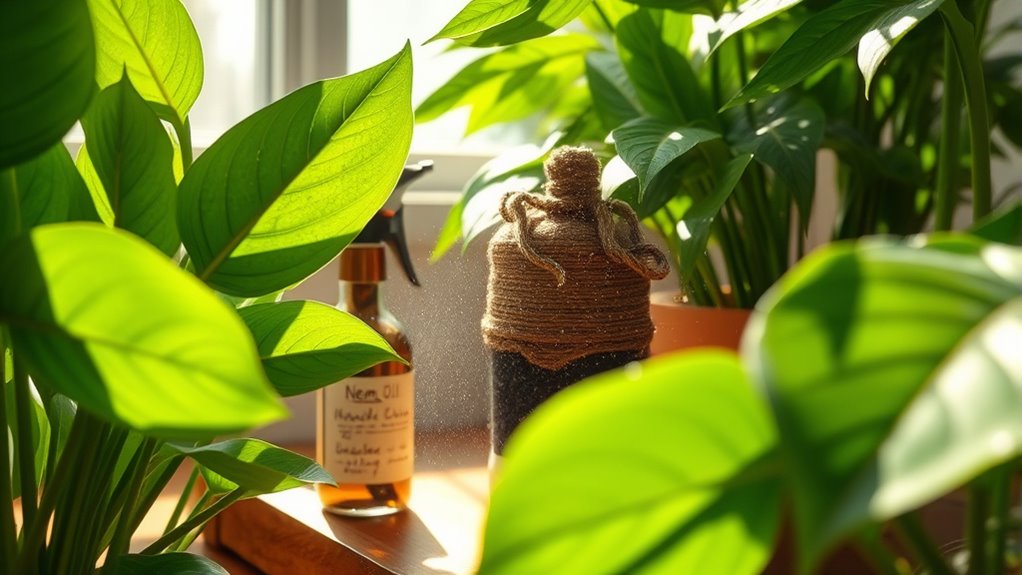
Preventive measures lay the groundwork for a healthy indoor garden, but when gnats do appear, utilizing neem oil and other natural pesticides can effectively manage the problem. Neem oil, derived from the seeds of the neem tree, works against various pests, including fungus gnats. You can apply it as a spray mixed with water and mild soap or as a soil drench to target larvae. Regular applications, ideally every week, keep pests at bay. Neem oil helps deter pests in plants and can alleviate potential pest accumulation between drenches. Additionally, incorporating chia seeds’ high fiber content into your diet can support overall health, which may indirectly benefit your gardening efforts. Furthermore, maintaining optimal soil pH is crucial for healthy plant growth and can help reduce the likelihood of pest infestations. Besides neem oil, consider using nematodes to control larvae, apple cider vinegar traps for adults, or even carnivorous plants to capture gnats. It is also beneficial to explore wickless candle making as a way to create a soothing atmosphere that can enhance your indoor gardening experience. Combining these methods enhances your pest control strategy, ensuring your plants stay healthy and thriving.
Monitoring Plant Health and Soil Conditions
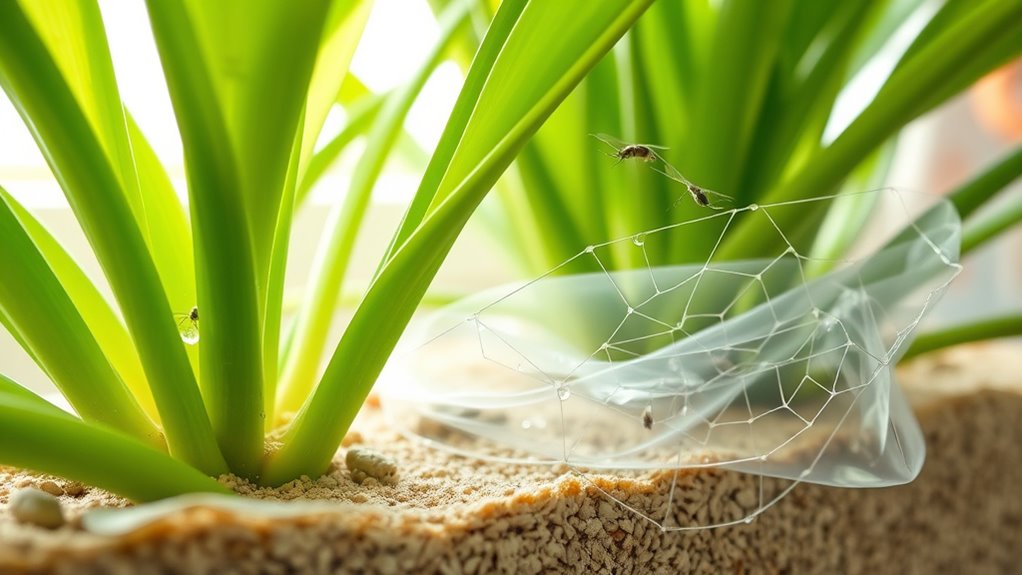
Keeping a close eye on your indoor plants’ health and soil conditions is essential for preventing gnat infestations. Use non-destructive sensors to detect internal plant signals, helping you spot stress early. Additionally, precision agriculture utilizes novel sensors that can help monitor your plants in real-time, ensuring optimal conditions for growth. Incorporating the right wicking materials can also enhance moisture management, further reducing the risk of gnats.
Incorporate electrochemical sensors to measure plant hormones, which can indicate if your plants are under stress. Employ imaging techniques to monitor changes in color and temperature that reveal health issues.
Remember to manage soil moisture carefully, as gnats thrive in damp conditions. Improve drainage by adding perlite or sand to your soil mix. Water plants from the bottom to minimize surface moisture.
Repotting and Soil Sterilization Strategies
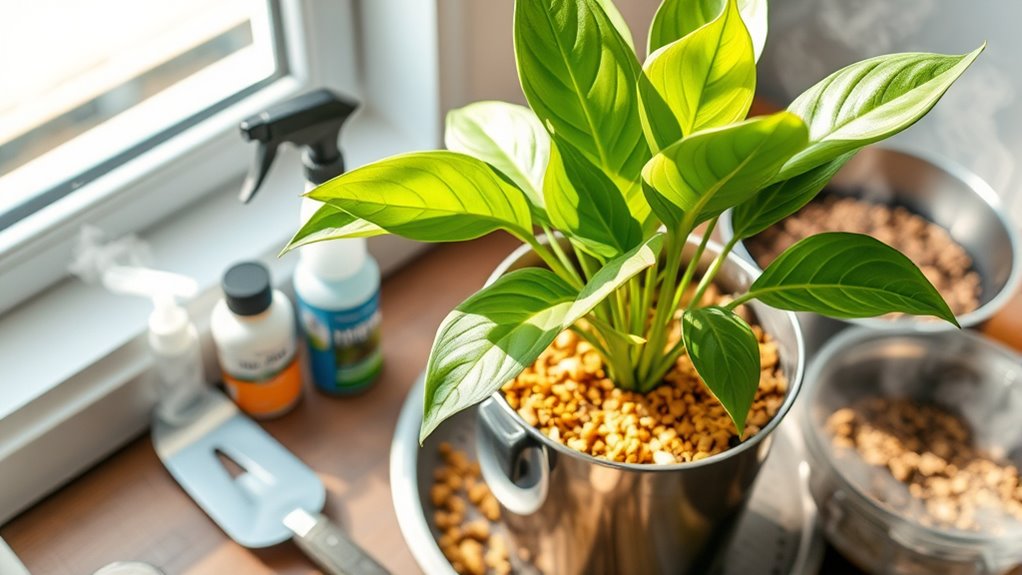
When you notice signs of gnat activity in your indoor plants, repotting and soil sterilization can be effective solutions.
Start by using fresh, sterile soil, as this eliminates larvae and eggs. Clean the pot with hot water and dish soap to remove any lingering pests. Remove all old soil to prevent reinfestation, as gnats thrive in moist environments. Additionally, be sure to rinse the roots thoroughly with room temperature water to ensure all organic matter is removed before repotting. This step is crucial as appliances included in a home can sometimes harbor pests if not properly maintained. Regular maintenance of appliances can enhance appliance efficiency and help keep your indoor environment pest-free.
If your plant needs a bigger home, choose a larger pot but avoid excessive moisture retention. For soil sterilization, consider soaking with diluted hydrogen peroxide or using beneficial nematodes.
Also, sprinkle cinnamon on the soil to deter gnats. Regularly check and maintain your plants, ensuring proper watering practices to keep gnats at bay.
Frequently Asked Questions
What Attracts Gnats to Indoor Plants Specifically?
Gnats are attracted to indoor plants mainly due to moisture, decaying organic matter, and overwatering. If your soil stays damp, it creates an ideal breeding ground for them.
They also thrive on organic debris, which serves as a food source. Additionally, high humidity levels and moderate temperatures in your home further entice these pests.
Be mindful of light sources too, as gnats are drawn to bright areas near your plants.
How Long Do Gnat Infestations Typically Last?
Gnat infestations typically last about three to five weeks, depending on environmental conditions.
If you overwater your plants, you’re creating an ideal habitat for them, which prolongs their presence. Multiple generations might coexist, making it tougher to eliminate them.
To shorten these infestations, you’ll need to actively manage moisture levels and use traps. Regular monitoring and proper care can help you prevent them from sticking around longer than necessary.
Can Gnats Damage My Indoor Plants?
Did you know that adult fungus gnats can lay up to 200 eggs in moist soil?
Yes, gnats can indeed damage your indoor plants. Their larvae feed on roots, leading to wilting, poor growth, and yellowing leaves.
If you notice adult gnats flying around, it’s a sign your plants might be suffering.
Are There Specific Plants That Repel Gnats?
Yes, there are specific plants that can help repel gnats. Consider adding lavender, citronella, rosemary, basil, and mint to your space. Their strong scents deter gnats effectively.
You can plant them in your garden or use potted versions on patios. Crushing the leaves enhances their fragrance, boosting their repellent properties.
Position these plants strategically near areas where gnats are frequent to maximize their effectiveness and keep your environment gnat-free.
How Do I Know if My Soil Is Infested With Gnats?
To know if your soil’s infested with gnats, look for adult gnats flying around your plants, especially after watering.
Dig a bit into the top few inches of soil; if you spot tiny, worm-like larvae with black heads, you’ve got a problem.
Also, watch for wilting, yellowing leaves, or stunted growth in your plants, which can signal root damage caused by these pests.
Regular checks can help you catch infestations early.
Conclusion
By taking these steps, you can reclaim your indoor oasis from pesky gnats. Imagine walking into your home, greeted by thriving plants and the sweet scent of fresh greenery—no swarming insects in sight. But don’t let your guard down; a single oversight could bring them back. Stay vigilant, keep monitoring, and remember: the battle against gnats isn’t just about keeping them away, it’s about nurturing your plants and preserving the tranquility of your space.

